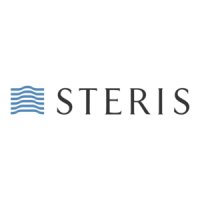
Do you have a question about the Steris InnoWave IW511020 Series and is the answer not in the manual?
| Category | Ultrasonic Jewelry Cleaner |
|---|---|
| Model | IW511020 Series |
| Ultrasonic Frequency | 42 kHz |
| Power Supply | 100-120 VAC, 50/60 Hz |
| Material | Stainless steel tank |
General safety precautions, warnings, and cautions for operating the equipment.
Specifies required Personal Protective Equipment (PPE) for safe operation.
Guidelines for safely transporting and storing the ultrasonic cleaner.
Recommendations for operator training to ensure safe and effective use.
Describes the primary function and intended use of the ultrasonic cleaner.
Outlines the key features and capabilities of the InnoWave Eco Ultrasonic Cleaner.
Visual identification of the main components and features of the ultrasonic cleaner.
Explains how to identify the equipment model, serial number, and manufacturer.
Provides contact and address details for the equipment manufacturer.
Lists the standards and regulations that the equipment complies with.
States the equipment's adherence to international decontamination standards and quality control.
Details the equipment's compliance with RoHS directives for hazardous substances.
Guidance on the proper disposal of the equipment and its materials.
Step-by-step instructions for safely unpacking the ultrasonic cleaner.
Lists all items included in the packaging with the equipment.
Instructions for connecting the drain hose to the equipment and site drain.
Guidance on how to install the disposable drain filter into the equipment.
Procedure for connecting and switching on the electrical power supply to the unit.
Overview of the touchscreen interface, screensaver, and PIN entry.
Explains how to navigate through the display menus and select options.
Details the functions accessible from the main menu via various symbols.
A flow diagram outlining the steps involved in performing a wash cycle.
Instructions on how to safely remove the instrument basket from the tank.
Procedures for cleaning the tank and lid before filling with water.
Guidance on properly loading instruments into the equipment basket.
Steps for correctly placing the loaded instrument basket into the ultrasonic tank.
How to adjust wash temperature, degas, and wash durations for a cycle.
Procedure for filling the tank with water and checking temperature.
Instructions on safely adding detergents and cleaners to the tank.
Lists recommended cleaning chemicals for use in North America.
Lists recommended cleaning chemicals for use outside North America.
Conditions required and steps to start a wash cycle.
Explains the symbols and information displayed during an active wash cycle.
Steps to follow when a wash cycle has successfully completed.
How to pause, resume, or abort an ongoing wash cycle.
Information on error codes, their causes, and corrective actions.
Procedure for draining the fluid from the ultrasonic tank.
Critical safety information to be observed before performing maintenance.
Daily routines for cleaning and inspecting the ultrasonic cleaner.
Weekly tasks for cleaning and inspecting the equipment.
How to view and verify the equipment's time and date settings.
Procedure for performing a complete decontamination of the ultrasonic cleaner.
Information on available accessories and approved replacement parts.
Recommendations for scheduled servicing by approved technicians.
Lists the functions accessible via the supervisor menu.
Steps to access and unlock the supervisor menu using a PIN.
Instructions for changing the supervisor PIN for menu access.
Procedure for changing the display language of the equipment.
Lists recommended brands of USB flash drives for data logging.
Step-by-step guide to download wash cycle logs to a USB drive.
Table of error codes, their messages, and suggested remedies.
Common performance issues and their potential causes and solutions.
Details on the equipment's performance characteristics and specifications.
Information on the required electrical power supply and voltage for the unit.
Specifications for the site drain connection and capacity.
Physical dimensions and weight specifications for different model variants.
Details on the internal tank dimensions and maximum liquid volume.
Specifications for the instrument basket dimensions and load capacity.
Lists the languages available for the display and wash cycle logs.
Environmental conditions for operation, including temperature and humidity.
Glossary of terms and definitions used throughout the operator manual.
Explains the meaning of various symbols found on the equipment and its labeling.